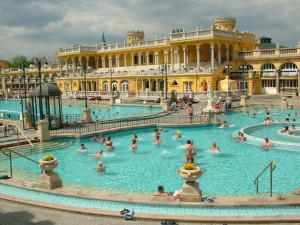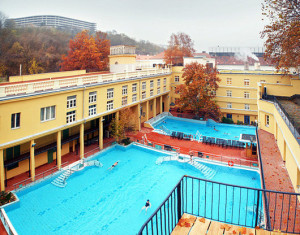
Budapest is the “City of Spas” without any doubt. There are 118 springs under the city of Budapest, and they provide 70 million liters of water every day. Thermal baths are one of the most interesting and enjoyable “sights” of the city, not only because of the thermal water, but also the beautiful architecture of the buildings.
Bath culture in Hungary and Budapest dates back to thousands of years ago. Celts and Romans were enjoying, drinking and bathing in the water coming from the ground, full of minerals. The Turks left their baths along the Danube on the Buda side, as memories of the Turkish occupation (1541-1686), and they are very much favored by locals and tourists nowadays. The currently functioning thermal baths of the city were built later on, and they are very much functional in the everyday Hungarian culture. Water sports – swimming, water polo, kayak, canoe – are greatly respected, spa complexes offer fun for young and old. Aqua therapy is a major part of Hungarian medical care. Doctors are recommending and ordering water treatments: aquafitness, weight bath, mud bath, massages, individual bath therapy or drinking therapy, are part of their everyday practice.
Thermal baths are often mixed with the Turkish baths, which are also popular in Budapest, but currently there are major differences between them. Thermal bath houses can be visited by men and women at the same time, while most of the Turkish baths are open on certain days for men, and on certain days for women, and some days, for both gender. Thermal baths have swimming pools inside or outside, while Turkish baths have no pools for swimming. Sauna is not a popular relaxing pastime in the Turkish culture, but all thermal baths offer this lovely way of relaxing as well.
The following top 3 thermal baths of Budapest offer a great bathing experience, with different temperatures of hot water (21-78 degrees celsius), and the stunning architecture amazes our vision.
Széchenyi bath (“Szecska”)
This is the biggest bath complex in Europe. The water of Széchenyi bath comes from a 1246 m deep well (second deepest well in Budapest), and its temperature is 76 degrees. The well itself was originally on the current Heroes’ Square, and it took 10 years (1868-1878) to reach its current depth. The bath house was opened to the public in 1913. The continuous popularity of the bath made it necessary to add more pools, and also a swimming pool of 50*18 meters, and this was the first swimming pool on the Pest side. WWII made a little damage in the building, but fortunately not the well, so the bath could function during the war as well. Currently there are 21 pools in the complex, and also a hospital with 178 beds has been working here since 1982.
Gellért bath
There used to be a natural water spring in the place of the current Gellért bath, as early as the 15th century. This spring was often visited by the Turks as well, as the water was much warmer here than other Buda baths. Between the 17th-19th centuries the bath was called “Sárosfürdő” (“mudbath”), referring to the mud that was found around the spring. Gellért bath and hotel was built in the Art Nouveau style, between 1912-18, and was opened in 1918. It was the first luxury hotel and bath of Budapest, and the most modern thermal bath of Europe. The famous wave pool was added to the pools in 1927. The bath was damaged seriously in WWII, but luckily the colored glass in the men’s section by Róth Miksa, Zsolnay mosaics, marble columns, some statues and glass remained from the original building. Water temperature is 26-40 degrees.

Lukács bath
In the 12th century, knights arrived to this part of Buda, and built monasteries around the natural springs. The Turks used the energy of the spring in the production of gunpowder and flour. After the Turks left Buda, the bath belonged to the Treasury, and Palotay Fülöp bought it in 1884. Reconstruction started and this was the most modern bath in Budapest, until Gellért was built. The grateful patients used to send a small marble plat, and for a long time they were hung on the walls of the bath. This was the first bath in Budapest that provided daycare hospital, opened in 1979. Lukács bath is the thermals bath that is visited mainly by locals.
*******************************************************************
Try more and different types of baths while visiting Budapest! Enjoy, taste and relax in our mineral water.
